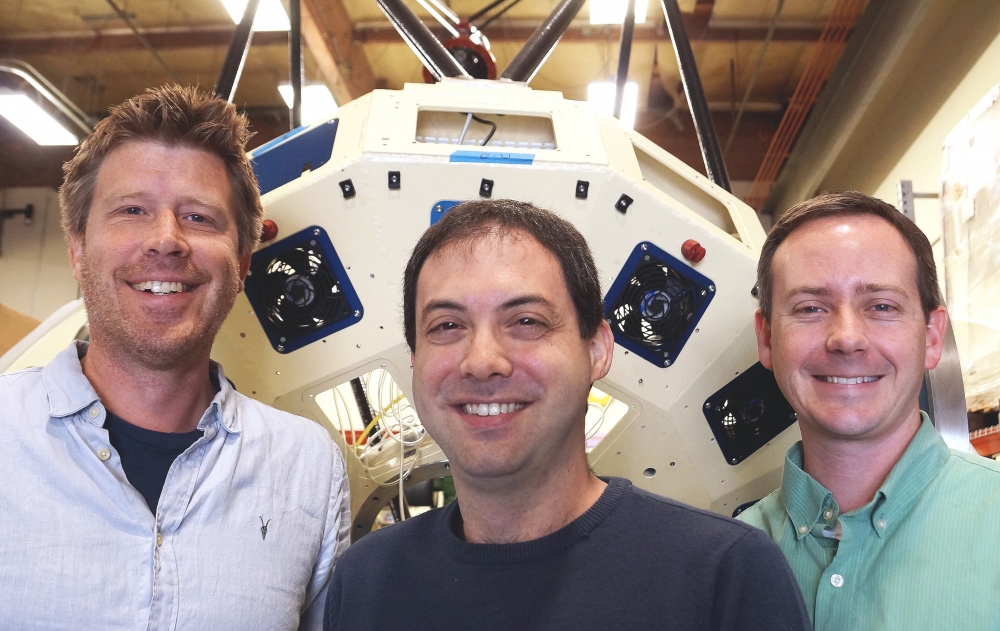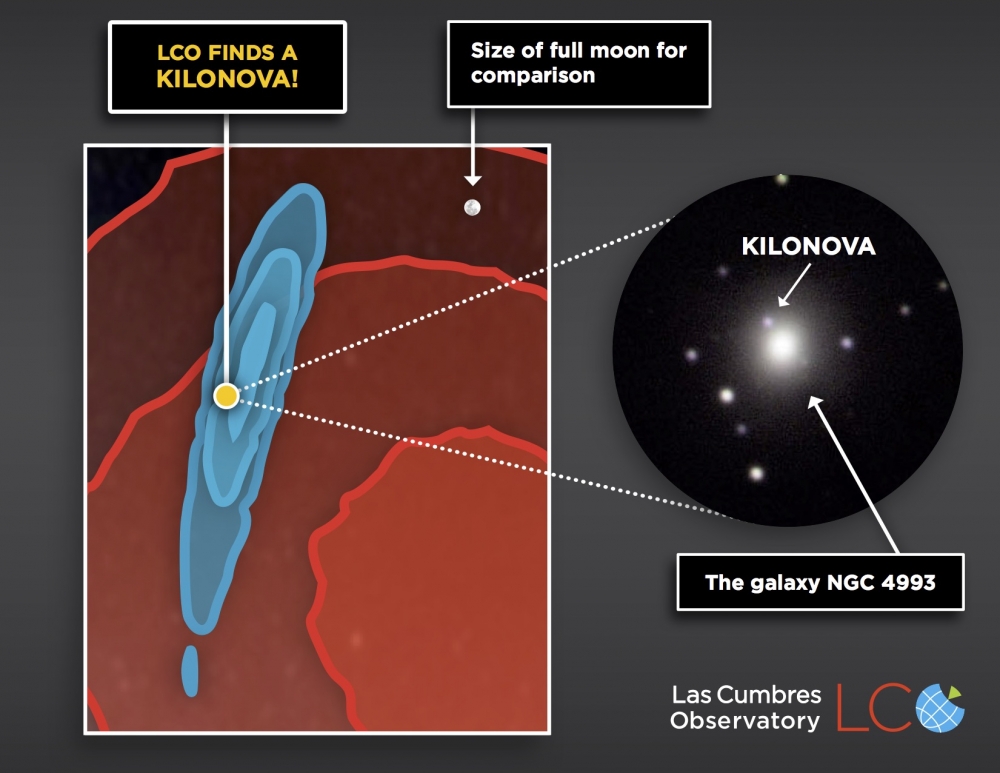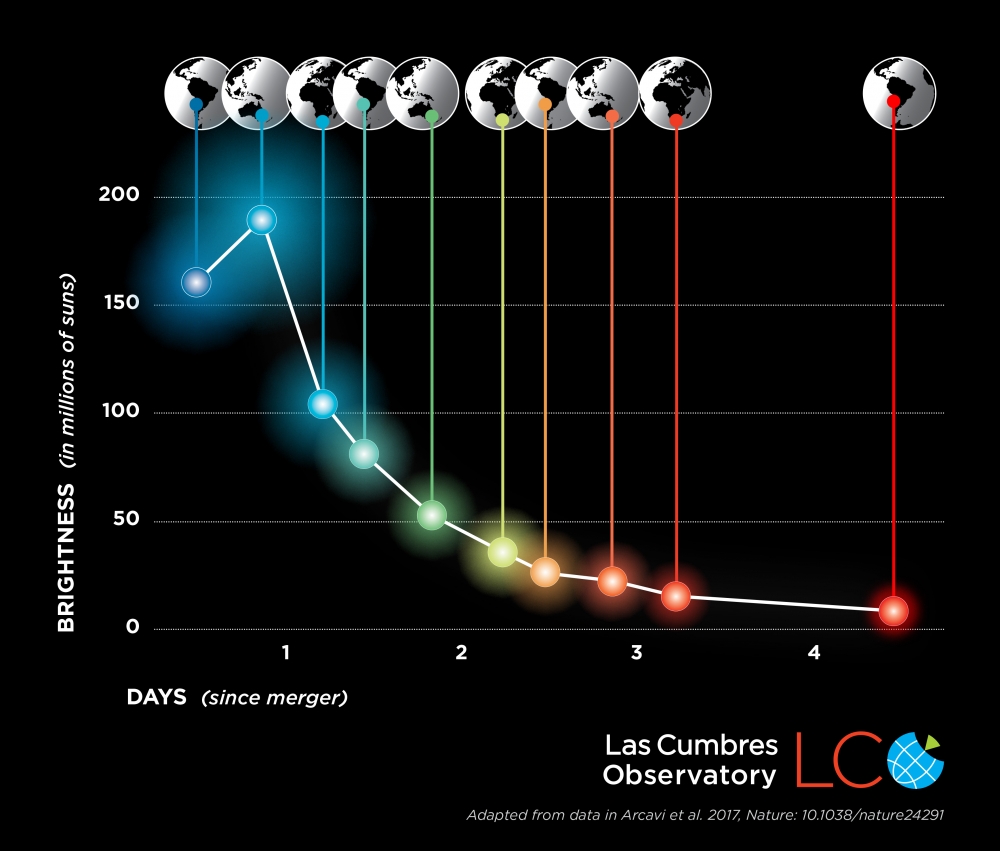Catch a Fleeting Kilonova

In the world of astrophysics, Aug. 17, 2017, was undoubtedly a red-letter day.
First, NASA’s orbiting Fermi satellite identified a burst of high-energy gamma rays. Then, in the minute leading up to the Fermi burst, scientists noticed microscopic distortions in space caused by gravitational waves passing through the Earth. When they combined the data from the two Laser Interferometer Gravitational-Wave Observatory (LIGO) facilities in Hanford, Washington, and Livingston, Louisiana, with the data from the Virgo detector in Italy, they realized they could localize the disturbance to a relatively small region of the sky — only about 150 times the size of the full moon — near the constellation Hydra.
Astronomers at Las Cumbres Observatory (LCO) in Santa Barbara activated their robotic network of 20 telescopes around the world and were one of six teams to co-discover a new source of light in that region and localize it to the galaxy NGC 4993, only about 130 million light years away.
“Such a gravitational wave signal had never been seen before but was unmistakably generated by two neutron stars spiraling together,” explained Iair Arcavi, a NASA Einstein postdoctoral fellow in UC Santa Barbara’s Department of Physics and leader of the LCO follow-up effort. The resultant study appears in the journal Nature.
The outburst that occurs right after two neutron stars merge is called a kilonova, a phenomenon that had long been theorized though never conclusively observed — until now. Unlike traditional ground-based facilities with single telescopes, the LCO network could observe the phenomenon every few hours for five consecutive days. During that time, the light from the explosion dimmed by a factor of 20, fading at an unprecedented rate for something so luminous.
“This marks the first time in history that an astronomical phenomenon has been first sensed through gravitational waves and then seen with telescopes,” Arcavi said. “For years, we’ve heard theorists predict how a kilonova should look. I couldn’t believe we were finally seeing one for the first time.”
Kilonovae are thought to be the primary source of all the elements heavier than iron in the universe. For example, most of the gold on Earth may have been created in a kilonova. The name originates from the prediction that a kilonova would be a thousand times brighter than a nova, though dimmer than a supernova.
“We know now that one reason they had been so elusive is that they fade too quickly for conventional astronomical facilities to detect,” Arcavi said.
“Thanks to knowing where to look and then having telescopes networked together all around the world, we were able to watch this new type of cosmic explosion rise and fade in real time,” said co-author Curtis McCully, a postdoctoral researcher at LCO and in the UCSB Department of Physics. “This is a remarkable story of the advent of gravitational wave astronomy combined with robotic internet-based optical astronomy.”
LCO astronomers also used their and other facilities around the world, including the 8-meter Gemini telescope in Chile, to split the light of the kilonova into its chromatic components: a rainbow. McCully led this study, which appears in The Astrophysical Journal Letters.
“We found that only a tiny amount of material was ejected in the explosion — only about 1 percent of the total matter in the system,” he noted. “The material was also flung out at an extraordinary speed, as much as 30 percent of the speed of light.”
The LCO group also contributed to a third study measuring the Hubble constant, which characterizes the expansion rate of the universe. That research used the inspiraling neutron stars as “standard sirens” to determine their distance from Earth and compared that distance to the redshift, or how much light has been stretched by the expansion of the universe. That study appears in the journal Nature.
“This is a game-changer for astrophysics,” said UCSB adjunct faculty member Andy Howell, who leads the supernova group at LCO and is co-author on the three studies. “A hundred years after Einstein theorized gravitational waves, we’ve seen them and traced them back to their source to find an explosion with new physics of the kind we’ve only dreamed about.”





